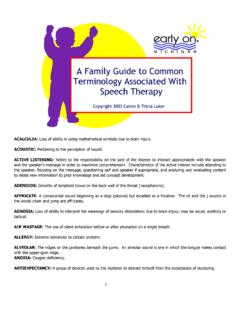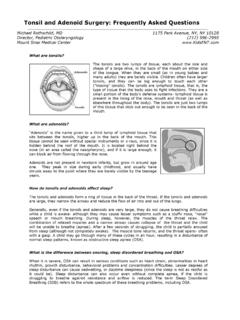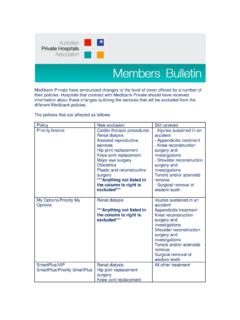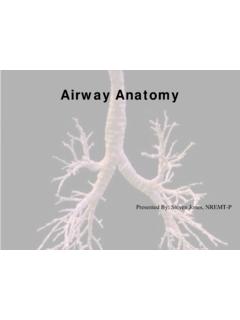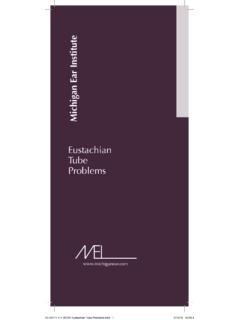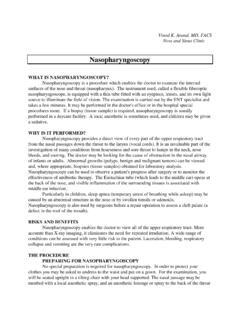Transcription of Obstructive Sleep Apnea - therapycenterwichita.com
1 NObstructive Sleep ApneanApnea is interruption of breathing for a certainamount of time, or when accompanied by achange in skin color. Obstructive Sleep Apnea (OSA) is an increasingly recognized problem inchildren. Symptoms include snoring at nightand feeling sleepy during the day. Diagnosis andtreatment are is Obstructive Sleep Apnea ? Obstructive Sleep Apnea is an interruption in breathing forlonger than the normal time because air (oxygen) is blocked(obstructed) from getting into the airway. Sometimes theobstruction is partial, allowing less air than normal to get Sleep Apnea (OSA) occurs most commonly inadults but is being recognized more often in children andteens. For various reasons, the upper airway temporarilygets blocked and doesn t stay as open as it should whileyour child is sleeping.
2 This can cause noisy breathing andsnoring. The episodes of Apnea may or may not wake yourchild up. Sometimes the airway is just partially blocked, soit s not true Apnea . However, this can still result in less airgetting to the lungs (called hypoventilation ).What does it look like?The main symptoms of OSA are: Snoring. Especially in severe OSA, snoring is the mostnoticeable symptom. (However, not all kids who snorehave OSA!) A period of loud snoring may be followed by a fewmoments of silence. You may hear a snort as yourchild starts breathing again; then snoring may startagain. Some children may appear to be struggling tobreathe. In others, you may hear very loud snoringthrough most of the night. Snoring is often quieter and less noticeable in childrenthan in adults.
3 This may make it more difficult torecognize OSA. Restless Sleep your child may wake up frequently duringthe night. Sleeping in odd positions, for example, with the neckstretched out. Daytime sleepiness your child may lack energy for theusual activities. Sleepiness at school may lead to poorgrades and other problems. Some children with OSAhave symptoms similar to those of attention deficit hyperactivity disorder (ADHD): inattentiveness, hyperac-tivity, behavior problems. Mouth breathingmay be a symptom, although mostchildren with OSA breathe normally when they areawake. Children with more severe OSA may breathenoisily during the day as causes Obstructive sleepapnea? The most common cause of OSA in children is enlargedtonsils and adenoids. The tonsils and adenoids are lymphtissue that are part of the immune system.
4 The tonsils arelocated in back of the throat and can be seen when themouth is open wide. The adenoids are farther down andcannot be seen. The main cause of enlarged tonsils andadenoids is repeated respiratory infections (such as sorethroats). In children, OSA is most frequent between ages2 and 5, when the tonsils and adenoids are relativelylarge compared with the airway. Congestion in the nose, such as caused by allergies, canoccasionally cause OSA. These children usually alsohave enlarged tonsils and adenoids. Some physical abnormalities can also increase the risk ofOSA. These include having a large tongue and small jaw,which may occur in children with certain genetic condi-tions. Obesity also increases the risk of OSA, but chil-dren with OSA are not necessarily obese; in fact, mostare not.
5 Children with certain neurologic conditions, suchas cerebral palsy, are also at increased are some possiblecomplications of Apnea ? If it is severe and frequent, OSA can lead to complica-tions affecting the heart, lungs, and brain, related to lackof oxygen. Most cases of severe childhood OSA aredetected and treated before these problems occur. Poor growth and weight gain (failure to thrive). Complications related to intellectual functioning andbehavior. Daytime sleepiness can interfere with yourchild s school work and other daily Obstructive Sleep apneabe prevented? Most cases of OSA in children are probably not preven-table. In obese children and teens with OSA, the problem ismore likely to continue into adulthood. Weight manage-ment should be a long-term 2007 by Elsevier448 How is Obstructive sleepapnea diagnosed?
6 The doctor will often recognize OSA from the child ssymptoms. In these cases, the problem is often enlargedtonsils and/or adenoids. If there is a lot of swelling and congestion in the nose,usually from allergies, the doctor may recommend treat-ment with allergy medications to see if that improvesthe OSA symptoms. Polysomnography( Sleep study). If the doctor isn t surewhether there is a Sleep -related breathing problem orhow severe it is, he or she may recommend a Sleep studycalled polysomnography (PSG). This is an overnight test,done at the hospital in a special Sleep laboratory. Your child will be hooked up to various machines thatmeasure how he or she is breathing while asleep, howmuch oxygen is in the blood, how frequently episodesof interrupted breathing ( Apnea ) occur and how longthey last, and how difficult it is for your child tobreathe during Sleep .
7 The test is not painful, although it could be scary for ayounger child. A parent is usually allowed to stayovernight with the child. The information gathered by PSG answers a lot ofimportant questions about the presence and severityof OSA. This helps determine the most is Obstructive sleepapnea treated?Treatments for OSA depend on your child s doctors may be involved in your child s treatment,depending on the cause of the problem. We may recom-mend a visit to a doctor specializing in ear, nose, and throatproblems (an otorhinolaryngologist or ENT) or to a specialistin lung and breathing problems (a pulmonologist). most children with OSA, the problem iscaused by enlarged tonsils and adenoids. Treatmentinvolves removing the tonsils and adenoids to createmore room in the throat for your child to breathe.
8 This ope-ration is called adenotonsillectomy taking the tonsils(adenoids) out. For children who are otherwise healthy, this operationhas a very high success rate. Problems with OSAusually clear up quickly. If your child is underweightor has been growing slowly, he or she may have catch-up growth after surgery. If problems other than enlarged tonsils and adenoidsare present such as obesity, cerebral palsy, or gene-tic diseases there is an increased risk that sleepapnea will still be present or will return after surgery,if done. Your child will need continued medicalfollow-up. Treatment for your child has problems withallergies, these may be treated first to see if the OSAsymptoms improve. Oral antihistamines and deconges-tants may be used. Often, steroids sprayed into the nose(nasal steroids) are more effective.
9 Continuous positive airway pressure (CPAP).If the doc-tor feels that surgery would not be helpful, or if surgerydid not solve the problem, he or she may recommend atreatment called CPAP. The CPAP machine produces mild air pressure to keepthe airway open while your child is sleeping. Themachine delivers air through smell tubes that fit inyour child s nose and mouth. Although it takes a littlegetting used to, CPAP is highly effective in reducingepisodes of Apnea . Most patients requiring CPAP arecared for by a specialist. Other operationsmay be recommended in certain situa-tions. For example, in children with facial deformities,reconstructive surgery may improve the problem withsleep should I call your office?Call our office (or your ENT doctor or pulmonologist)if your child continues to have symptoms of OSA aftertreatment: Snoring, noisy breathing.
10 Waking up at night for no obvious reason, especially withsnoring. Daytime Sleep Apnean449 Copyright 2007 by Elsevier
